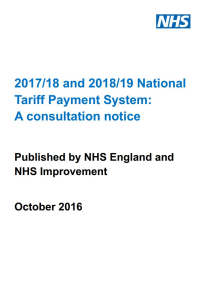News / Two-year tariff confirmed in consultation notice
The headline change in is to set the tariff for two years. This aligns with the two-year planning guidance and contracting round, giving systems more financial certainty to underpin plans for the second of the two years, 2018/19. A two-year tariff will also limit the opportunity for new policies to be brought in for year two – as the tariff cannot be changed without a new consultation on the whole tariff. 
The two-year tariff will also mark the first use of the new healthcare resource group currency design (HRG4+) in the payment system. The more granular HRG4+, which has been used in reference cost collections, uses complexity and comorbidity scores to split HRGs and better reflect relative complexity.
Alongside this change, system leaders are also proposing new and updated top-up payments for specialised services and a transition path to limit financial impacts. The new top-up rates reflect the fact that a more granular tariff reduces the need for such top-ups. However there are no plans to introduce a marginal rate for specialised services in the next two-years.
A 2% efficiency factor will be used in both years. With a 2.1% uplift for costs, again for both years, this will mean a small 0.1% general increase in tariff prices each year. Additional Clinical Negligence Scheme for Trusts (CNST) uplifts are applied at an HRG sub-chapter level. This targeting approach recognises the link between CNST costs and the mix of services delivered by different providers.
A general smoothing mechanism will adjust prices in some sub-chapters to prevent major year-on-year swings in income for some providers.
There has been limited progress towards the use of new currencies for contracting for mental health services in recent years. In an attempt to force the pace, the new tariff requires commissioners and providers to implement either a capitated or episodic payment approach for adult and older people mental health services. Both approaches will require an element of payment to be linked to locally agreed quality and outcome measures.
A new payment model for improving access to psychological therapies will also be mandated from April 2018.
There was also confirmation that the early summer proposal to replace follow-up outpatient appointment tariffs with a block payment has been abandoned. The aim had been to reduce the number of unnecessary follow-up appointments and encourage different ways of providing outpatient care – for example using telephone appointments or technology.
System leaders still want to encourage this, but will now do so by transferring up to 30% of follow-up outpatient appointment costs into the first appointments tariff - again as trailled in the planning guidance. There is already a fixed 10% transfer in operation, but the new tariff will see two further levels (20% and 30%) added for some specialties.
An impact assessment and other supporting documents are due to be published next week (8 November). At this point the formal consultation on the proposals will start. This consultation, which runs until 6 December, offers stakeholders the chance to tell NHS Improvement and NHS England what they think about the proposals. Clinical commissioning groups and relevant providers can also raise objections – but only to the method proposed for determining national prices.
Related content
We are excited to bring you a fun packed Eastern Branch Conference in 2025 over three days.
This event is for those that will benefit from an overview of costing in the NHS or those new to costing and will cover why we cost and the processes.